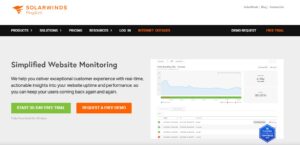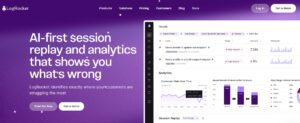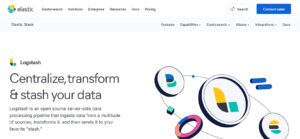Uptrace has carved a niche in the APM ecosystem by offering lightweight tracing, Prometheus integration, and native OpenTelemetry support — all with a minimal footprint. But as teams expand their environments and compliance needs, Uptrace’s limited full-stack support, lack of enterprise-grade hosting, and growing maintenance overhead are pushing many to explore more robust alternatives. It’s focus is on tracking and lacks critical capabilities like Real User Monitoring (RUM) and native synthetic monitoring—two core pillars of modern observability that are rapidly becoming must-haves.
According to industry reports, synthetic monitoring is expected to grow at a CAGR of 15.30% during the forecast period of 2025-2034 to attain a value of USD 6090.99 Million by 2034. This underscores the highlighting the demand for proactive performance tooling.
CubeAPM stands out as the most powerful Uptrace alternative. With a pricing model starting at $0.15/GB and zero per-user fees, it offers unmatched cost-efficiency. It delivers full-stack observability, real-time distributed tracing, and smart sampling, while also supporting on-prem deployments to meet compliance requirements. With built-in support for OpenTelemetry, Prometheus, and seamless agent migration, CubeAPM lets teams cut observability costs by up to 80% without compromising on performance.
In this article, we break down the top 7 alternatives to Uptrace in 2025, comparing tools based on observability coverage, deployment flexibility, cost transparency, OpenTelemetry compatibility, and more.
Table of Contents
ToggleTop 7 Uptrace Alternatives
- CubeAPM
- Datadog
- Dynatrace
- Splunk Appdynamics
- New Relic
- Better Stack
- Coralogix
- Sumo Logic
Why Look for Uptrace Alternatives?
While Uptrace is a capable OpenTelemetry-native observability tool, it remains limited in several key areas that matter once teams scale into production or operate across multiple services and environments:
1. Basic Sampling Only – No Adaptive or Tail Based Logic
Uptrace relies entirely on static, manual OpenTelemetry sampling configurations. It lacks dynamic, context-aware sampling — the kind that prioritizes traces based on latency spikes, error codes, or anomaly patterns. Without intelligent sampling, teams either overspend by ingesting too much, or miss critical data by dropping the wrong traces.
2. Gaps in Full-Stack Observability
Although Uptrace technically supports the MELT stack via OTEL, it does not natively provide essential components like Real User Monitoring (RUM) or synthetic monitoring. This means there’s no built-in visibility into frontend performance or the ability to simulate and test user journeys proactively. Teams must stitch together third-party tools to achieve full coverage — adding cost, complexity, and integration risk.
3. Operational Overhead at Scale
Running Uptrace in production means managing your own observability infrastructure — including ClickHouse, OTEL Collectors, storage retention, alerting configs, and visualization. This approach may work for small environments, but becomes a major maintenance burden in fast-growing or compliance-heavy teams. There’s no automation for scaling storage or HA, and tuning performance is entirely manual.
4. Minimal UI and Limited Alerting Capabilities
Uptrace’s built-in dashboards are basic and not optimized for large-scale, service-oriented environments. Alerting is limited to basic threshold-based rules, with no built-in anomaly detection, historical baselines, or deep correlation. This results in more false positives — and more missed incidents.
5. Limited Ecosystem Integrations
Out of the box, Uptrace has limited integration ecosystem which is a major disadvantage for teams with running distributed systems with diverse environment.
Criteria for Suggesting Uptrace Alternatives
To identify the best Uptrace replacements, we evaluated each tool based on a mix of operational, technical, and business-critical factors, including:
Criteria for Suggesting Uptrace Alternatives
When evaluating alternatives to Uptrace, we considered a mix of technical capabilities, deployment flexibility, and cost-effectiveness. While Uptrace is OpenTelemetry-native and supports both SaaS and on-premise deployment, it lacks several advanced features and enterprise capabilities that teams increasingly require at scale.
Here are the key criteria we used to select better-suited Uptrace alternatives:
1. Full-Stack Observability
Modern teams need end-to-end visibility — from backend traces to frontend performance. We focused on tools that offer complete MELT support (Metrics, Events, Logs, Traces) along with real user monitoring (RUM) and synthetic monitoring. Uptrace lacks these frontend observability features, creating visibility gaps across the user journey.
2. Smart Sampling & Signal Optimization
We prioritized tools that go beyond static sampling and offer intelligent, context-aware sampling — helping teams reduce data volume while capturing the most relevant signals. Uptrace supports OTEL-level sampling but lacks the dynamic trace prioritization that tools like CubeAPM and Dynatrace offer.
3. Hosting Flexibility & Deployment Control
While Uptrace supports both SaaS and self-hosted deployment, many alternatives offer more mature SaaS experiences, automated scaling, and enterprise SLAs. We selected tools that give teams fine-grained control over data residency, compliance, and hybrid deployments, whether they prefer cloud-native or on-prem environments.
4. Cost Efficiency & Transparent Billing
Tools that avoid per-user pricing and offer flat or usage-based billing scored higher. For instance, CubeAPM charges $0.15/GB for ingestion, with no hidden licensing or data retention fees. This translates to up to 80% savings over tools like Datadog or New Relic.
Uptrace’s Tiered Pricing Becomes Expensive at Scale Compared to CubeAPM’s Flat-Rate Model
Uptrace follows a dual pricing model: data ingestion is billed at a tiered rate starting around $0.08/GB, and metrics are charged at $2 per 1,000 active time series, with limited included capacity. For a mid-sized enterprise ingesting 10 TB of traces/logs per month, the total ingestion cost would be approximately $644/month, after volume discounts. If the environment generates around 1.3 million active time series, metric costs would add roughly $2,598/month. This brings the total estimated monthly cost to ~$3,242, making Uptrace significantly more expensive at scale than flat-rate observability platforms like CubeAPM.
CubeAPM, on the other hand, would charge a flat $1,536/month for the same data volume (10,240 GB × $0.15), while also including infrastructure monitoring, smart sampling, synthetics, RUM, and unlimited users at no extra cost.
So while Uptrace may appear cheaper per GB, once metrics scale — as they inevitably do in real-world environments — CubeAPM’s simple, all-inclusive pricing becomes significantly more predictable and cost-efficient.
5. Ease of Use & Operational Simplicity
Tools with a lightweight setup, clean UI, and fast onboarding process received higher preference. CubeAPM can be deployed and configured within an hour, compared to the steep learning curves of some enterprise solutions.
6. Enterprise Support & Incident Readiness
We assessed tools based on support SLAs, response channels (e.g., Slack, ticketing), and onboarding resources. Tools like CubeAPM offer Slack-based support with sub-5-minute response times, giving teams peace of mind during critical incidents. Uptrace’s support is largely community-driven and may not meet the needs of large production teams.
1. Uptrace Overview

Known for:
OpenTelemetry-native distributed tracing and metrics collection. Uptrace is an observability platform built around OpenTelemetry and ClickHouse. It’s popular among small teams looking for cost-effective, vendor-neutral tracing infrastructure.
Standout Features:
- Native OpenTelemetry support: Seamless OTEL ingestion without custom agents or wrappers.
- ClickHouse backend: Offers high-speed analytics on trace data using SQL.
- Basic metrics integration: Prometheus-compatible metrics ingestion.
- Minimal UI/UX: Lightweight, fast-loading interface for basic diagnostics.
Key Features:
- Distributed tracing using OpenTelemetry across services.
- Self-hosted deployment with support for Docker collector Setups.
- Prometheus integration for system and service-level metrics.
- SQL-based trace queries using ClickHouse for advanced users.
- Basic dashboards and alerting for trace anomalies.
Pros:
- Fully OpenTelemetry-native; no vendor lock-in.
- Cost-effective for small-scale deployments (free community version).
- Supports custom deployments and runs entirely within your infrastructure.
- Easy integration with Prometheus metrics.
Cons:
- No real user monitoring (RUM), synthetics,—limited to traces, logs and metrics.
- Lacks smart sampling or dynamic data prioritization.
- Poor dashboarding experience compared to Grafana or CubeAPM.
- High operational overhead to manage ClickHouse, OTEL Collector, and configs.
- Minimal enterprise support; lacks SLAs, onboarding help, or managed hosting.
- Scalability & Enterprise Readiness Not Proven
- Incomplete Documentation & Feature Maturity
Best for:
- Small teams or startups with strong DevOps expertise.
- Teams comfortable managing self-hosted observability stacks.
- Environments prioritizing trace-based debugging over full MELT coverage.
Pricing & Customer Reviews:
- Pricing: Traces and Logs starts at $0.08 per gb and Metrics starts at $0.001 per series
- ProductHunt Rating: 4.8/5
Top 8 Uptrace Alternatives
1. CubeAPM

Known for:
Full-stack OpenTelemetry-native observability with cost-efficiency and smart sampling.
CubeAPM is an enterprise-grade observability platform that delivers full MELT coverage (Metrics, Events, Logs, Traces) with blazing-fast ingestion, compliance-friendly self-hosting, and 60–80% lower TCO compared to legacy APM tools.
Unlike legacy platforms that rely on cloud-only infrastructure and rigid pricing models, CubeAPM is designed for modern teams that demand flexibility, performance, and full control over their data. Built from the ground up with OpenTelemetry at its core, CubeAPM enables organizations to ingest, analyze, and act on telemetry data in real-time — without being locked into proprietary agents or escalating per-seat costs.
What truly sets CubeAPM apart is its ability to handle high-throughput observability workloads while keeping both cost and latency low. By processing data locally — instead of routing every trace or log through third-party cloud services — CubeAPM delivers 2–4x faster response times, faster dashboards, and stronger compliance posture. This makes it the ideal choice for SRE and platform teams managing large-scale, latency-sensitive environments.
Key Features:
1. Smart Sampling
Context-aware sampling dynamically retains high-value data (e.g., latency spikes, 5xx errors) while filtering noise. This reduces ingestion volume and cost without losing important traces.
2. Real-Time Tracing & Metrics
End-to-end distributed tracing combined with metrics from infra and apps.
3. Infrastructure Monitoring
Built-in support for AWS, Kubernetes, and Linux-based infra metrics.
4. Synthetic Monitoring & RUM
Simulate user flows and monitor real-world frontend performance.
5. Full OTEL and Prometheus Compatibility
Ingest any telemetry data without vendor lock-in.
Standout Features:
- Smart sampling enables high signal-to-noise ratio and efficient storage.
- On-prem hosting that complies with data residency laws and avoids public cloud egress fees.
- Unlimited user seats with flat usage-based pricing—no per-user charges like New Relic or Datadog.
- Instant migration support from Datadog, New Relic, or Uptrace in under an hour.
- High-resolution dashboards with customizable MELT views and anomaly alerting.
Pros:
- Up to 80% lower cost compared to Datadog, New Relic, and others.
- Smart sampling enables high signal-to-noise ratio and efficient storage.
- Full MELT coverage including logs, metrics, RUM, synthetics, and error tracking.
- Slack/WhatsApp support from core engineers with response times in minutes.
- Designed for self-hosted observability at scale.
Cons:
- Not suited for teams looking for off-prem solutions
- Strictly an observability platform and does not support cloud security management
Best for:
- Engineering orgs seeking lower cost and control over telemetry
- Startups and mid-sized teams scaling fast but watching budgets
Pricing & Customer Reviews:
- Pricing: Ingestion-based pricing of $0.15/GB
- Rating: 4.7/5 (based on pilot programs, Slack feedback, and demos)
CubeAPM vs Uptrace:
While Uptrace focuses on tracing and metrics, CubeAPM offers full-stack observability, including logs, infra, synthetics, and RUM. It also delivers smart sampling, which Uptrace lacks, and supports compliance-ready hosting out of the box. CubeAPM is the go-to choice for teams scaling past Uptrace’s capabilities without inflating costs.
2. Datadog

Known for:
Cloud-native full-stack observability platform with deep integrations across the DevOps ecosystem. Datadog is one of the most widely used SaaS-based observability platforms, offering infrastructure monitoring, APM, log analytics, and security monitoring — all from a single control plane.
Key Features:
- Infrastructure Monitoring: Agent-based host and container metrics with built-in dashboards.
- Application Performance Monitoring (APM): Distributed tracing across services, databases, and APIs.
- Log Management: Centralized log aggregation with Live Tail and search capabilities.
- Security Monitoring: Detect vulnerabilities and compliance violations in real time.
- Synthetic Monitoring & RUM: Test user journeys and monitor real frontend performance.
- Custom Dashboards and Alerting: Rich visualization engine with threshold, anomaly, and composite alerts.
Standout Features:
- 900+ integrations with tools like AWS, Kubernetes, Jenkins, and GitHub.
- Watchdog AI engine automatically surfaces anomalies and trends.
- Unified platform for logs, infra, APM, RUM, and cloud security — in one pane.
- High scalability for large multi-region deployments with real-time metrics.
Pros:
- Feature-rich and mature across all observability domains.
- Excellent support for multi-cloud and containerized environments.
- Intuitive dashboards, AI-powered alerts, and great documentation.
- Smooth integration into modern CI/CD workflows.
Cons:
- Expensive at scale — pricing is fragmented across ingestion, hosts, events, and feature tiers.
- No smart sampling — relies on fixed-rate, probabilistic sampling (1%, 5%) which misses anomalies.
- Opaque billing — many users complain about surprise bills and unpredictable costs.
- Limited self-hosting options — SaaS only, which can violate data localization requirements.
- Charges per-user, per-host, per-GB, which adds up fast in distributed environments.
Best for:
- Enterprises that need a one-stop-shop for DevOps observability, especially in cloud-native ecosystems.
- Teams with large budgets prioritizing out-of-the-box integrations and dashboards.
Pricing & Customer Reviews:
- Pricing:
- APM: starts at $31/host/month;
- logs – Effective Cost: $0.1/GB + $1.7/M events (15d), synthetics billed separately;
- Infra Cost; starting at $15/host/month
- G2 Review Rating: 4.4/5
While users praise Datadog’s deep feature set and integrations, common complaints center around pricing complexity, overages, and vendor lock-in. Many also report performance slowdowns at higher volumes.
Datadog vs Uptrace:
Datadog offers far more features than Uptrace (e.g., security monitoring, synthetics, logs, and RUM), but comes at a steep cost with complex billing. Uptrace may be better for early-stage startups, but Datadog is a clear upgrade — if budget is not a constraint. However, teams seeking cost-efficient, OpenTelemetry-native observability often choose tools like CubeAPM over both.
3. Dynatrace

Known for:
AI-driven full-stack observability and automation for enterprise-scale environments.
Dynatrace is a premium observability platform known for its powerful AI engine (Davis), auto-discovery, and deep code-level diagnostics — making it popular with large enterprises running complex hybrid cloud infrastructure.
Key Features:
- Davis AI Engine: Dynatrace’s AI-powered engine auto-correlates metrics, traces, and logs to detect and predict anomalies.
- Full-Stack Monitoring: Unified visibility from infrastructure to user experience (including synthetics, RUM, and logs).
- Automatic Dependency Mapping: Auto-discovers services, APIs, databases, and their dependencies.
- Log Management & Indexing: Context-rich log ingestion with dynamic log sampling and indexing.
- Cloud-Native Support: First-class support for Kubernetes, serverless, and multicloud environments.
- Code-Level Tracing & Insights: Drill into execution paths and bottlenecks with JVM, .NET, Node.js, and more.
Standout Features:
- No manual configuration — everything auto-instrumented and auto-discovered.
- AI-powered root cause analysis that reduces mean time to resolution (MTTR).
- Business KPI monitoring integrated into observability flows.
- Application Security Module for vulnerability detection.
Pros:
- Enterprise-grade scalability with strong automation.
- Exceptionally detailed tracing and performance diagnostics.
- Real-time anomaly detection without heavy tuning.
- Seamless hybrid cloud support with distributed tracing.
Cons:
- High pricing and opaque billing for AI, logs, and cloud modules.
- Proprietary agent and instrumentation — minimal OpenTelemetry compatibility.
- Limited flexibility for custom dashboards compared to Grafana or CubeAPM.
- Self-hosting possible, but complex compared to OTEL-native platforms.
Best for:
- Large enterprises and Fortune 500s needing automated observability at scale.
- Teams looking for predictive diagnostics, not just monitoring.
Pricing & Customer Reviews:
- Pricing: $0.08/hour per 8 GiB host (~$57.60/host/month)
- G2 Review Rating: 4.4/5
Users love its automation and Davis AI engine but flag pricing opacity, steep learning curve, and rigid agent-based instrumentation as downsides.
Dynatrace vs Uptrace:
Dynatrace delivers far deeper observability than Uptrace — with automated service maps, predictive AI, and security coverage. However, it’s not OpenTelemetry-native, and its high pricing makes it inaccessible for smaller teams. Uptrace is more lightweight but lacks the intelligence and enterprise capabilities that define Dynatrace. For OpenTelemetry-first teams, CubeAPM offers a powerful, lower-cost middle ground.
4. Splunk AppDynamics

Known for:
Enterprise-grade APM with deep application diagnostics and business transaction monitoring. Originally developed by Cisco (AppDynamics) and now integrated into Splunk’s observability suite, Splunk AppDynamics is geared toward large organizations needing detailed performance analysis tied to business KPIs.
Key Features:
- Business Transaction Monitoring: Tracks end-to-end flow of transactions across services and infrastructure.
- Application Performance Management (APM): Offers deep performance metrics and root-cause diagnostics for application components.
- Infrastructure Visibility: Correlates application behavior with underlying server, container, and cloud performance.
- Custom Dashboards & Health Rules: Alerts based on business outcomes, user experience, and performance SLAs.
- Synthetic Monitoring: Simulates user interactions to detect performance bottlenecks proactively.
- Code-level Diagnostics: Visual code traces and method-level insights for Java, .NET, PHP, and Node.js.
Standout Features:
- Tight application-to-business mapping helps IT and business leaders align on performance goals.
- Tag-based Smart Alerting and SLA tracking built into the UI.
- Deep diagnostics of monolith and legacy architectures.
- Recently enhanced by Splunk’s observability stack for extended log and infra visibility.
Pros:
- Ideal for transaction-heavy applications like e-commerce or finance platforms.
- Highly detailed performance breakdowns at method, class, and tier level.
- Business-centric alerting with SLA and KPI correlation.
- Part of a larger Splunk ecosystem with advanced logging and SIEM.
Cons:
- Complex setup and configuration — especially for custom instrumentation.
- High cost for full-stack deployment including APM, infrastructure, and synthetics.
- Limited native OpenTelemetry support (still agent-driven).
- UI feels dated and less intuitive compared to modern tools like CubeAPM or Grafana.
Best for:
- Large-scale enterprises with Java/.NET apps needing business-centric APM.
- Teams already using Splunk for logs or SIEM and want a consolidated ecosystem.
Pricing & Customer Reviews:
- Pricing: $75/host/month, billed annually
- G2 Review Rating: 4.3/5
Splunk AppDynamics vs Uptrace:
While AppDynamics provides much deeper application diagnostics and business KPIs than Uptrace, it does so at the cost of agent lock-in, high licensing fees, and setup complexity. Uptrace is simpler and open-source, but not enterprise-grade. CubeAPM stands out as the OTEL-native, business-aware alternative with self-hosting, advanced dashboards, and no per-user fees.
5. New Relic

Known for:
A usage-based, full-stack observability platform that covers everything from APM and infrastructure monitoring to logs, RUM, synthetics, and mobile telemetry. New Relic is recognized for its unified Telemetry Data Platform (TDP) and dashboarding powered by its query language, NRQL.
Key Features
1. Full MELT Observability: Offers integrated support for metrics, events, logs, traces, RUM, synthetics, and error tracking—all accessible from a single UI.
2. Telemetry Data Platform (TDP): Acts as a centralized ingestion and query engine for all telemetry data—including OTEL, Prometheus, and custom agents.
3. Dashboards & NRQL Analytics: Real-time data querying and flexible dashboards with New Relic Query Language (NRQL) for in-depth telemetry analytics.
4. RUM, Synthetics, and Mobile Monitoring: Robust browser and mobile performance monitoring with detailed session tracking and uptime monitoring.
5. Integrations & Auto Instrumentation: Supports auto-instrumentation for many languages and platforms; integrates with AWS, Azure, Kubernetes, and more.
Standout Features
- Telemetry Data Lake: Stores and queries logs, metrics, and traces from a unified backend.
- Rich Dashboards with NRQL: Enables deep slice-and-dice analytics across telemetry dimensions.
- All-in-One Observability: Offers MELT support in one suite (though some depth depends on using New Relic agents).
Pros
- End-to-end observability with one UI
- Flexible ingestion of OpenTelemetry and Prometheus data
- Strong support for frontend (RUM) and mobile observability
- Easy onboarding with auto-instrumentation for many languages
- Mature alerting, SLOs, and anomaly detection capabilities
Cons
- Pricing Complexity: Charges for ingestion and per user—can lead to spiraling costs
- User Licenses Are Expensive: Full-access licenses start at $400/user/month
- Data Residency Issues: Data stored on New Relic’s global cloud; no control over region or infrastructure
- Limited OTEL Support: Ingestion is supported, but feature depth is reduced unless using New Relic’s native agents
- No Smart Sampling: Relies on head-based sampling—missing key traces under high volume
Best For
Mid-to-large DevOps teams that want quick setup, rich dashboards, and all-in-one observability—and are comfortable with cloud-only, usage-based pricing.
Pricing & Customer Reviews
Free Tier: Perpetual free tier and 100 GB/month of data ingest included.
Paid: Ingestion based pricing of $0.35/GB + $400/user/month for full access
G2 Rating: 4.4/5
6. Better Stack

Known for:
Log and uptime monitoring with sleek dashboards and developer-friendly UX.
Better Stack (previously Better Uptime) combines log monitoring, incident alerting, and uptime checks with beautifully designed dashboards — ideal for developers who want lightweight observability with minimal setup.
Key Features:
- Uptime Monitoring: HTTP, ping, port, and SSL checks with on-call schedules and status pages.
- Log Management: Built-in logging platform with SQL-like search, alerting, and retention controls.
- Incident Management: On-call scheduling, incident tracking, and escalation workflows.
- Team Collaboration: Slack, MS Teams, and email integrations for fast alert routing.
- Custom Dashboards: Clean, modern UI with Markdown support and status reporting.
- Developer Experience: Fast onboarding with YAML config and Git-based alert workflows.
Standout Features:
- One of the cleanest UIs in observability — perfect for startups and indie teams.
- Combines uptime monitoring and log management in a unified product.
- Free plan for basic monitoring use cases with generous limits.
- Status pages, incident logs, and alerts for public communication.
Pros:
- Easy to use, no steep learning curve.
- Ideal for frontend, APIs, and external service uptime monitoring.
- Fast search across logs with real-time alerting.
- Simple, elegant dashboards great for public or internal status pages.
Cons:
- No distributed tracing or APM — lacks full MELT observability.
- Not suitable for complex microservices or backend-heavy architectures.
- Limited scalability for logs beyond a few GB/day without premium pricing.
- No support for OpenTelemetry, synthetic monitoring, or smart sampling.
Best for:
- Solo developers, startups, and small teams needing basic monitoring and logs.
- Teams looking for a better alternative to Pingdom or basic uptime checkers.
Pricing & Customer Reviews:
- Pricing:
- Free plan: Includes 10 monitors, 500MB logs/day, basic alerting
- Paid plans are in bundles starting from $25 based on Traces, Logs and Metrics to an upward of $850.
- G2 Review Rating: 4.6/5
Developers love the UX and the simplicity, but many note that it lacks the deep features of traditional APMs or observability tools.
Better Stack vs Uptrace:
Better Stack is a logging + uptime monitoring platform, whereas Uptrace is built for traces and metrics. Neither provides full-stack observability. But for teams prioritizing frontend uptime and lightweight alerting, Better Stack is a better fit. For backend or infra observability, CubeAPM delivers full MELT coverage with OpenTelemetry, smart sampling, and infra dashboards.
7. Coralogix
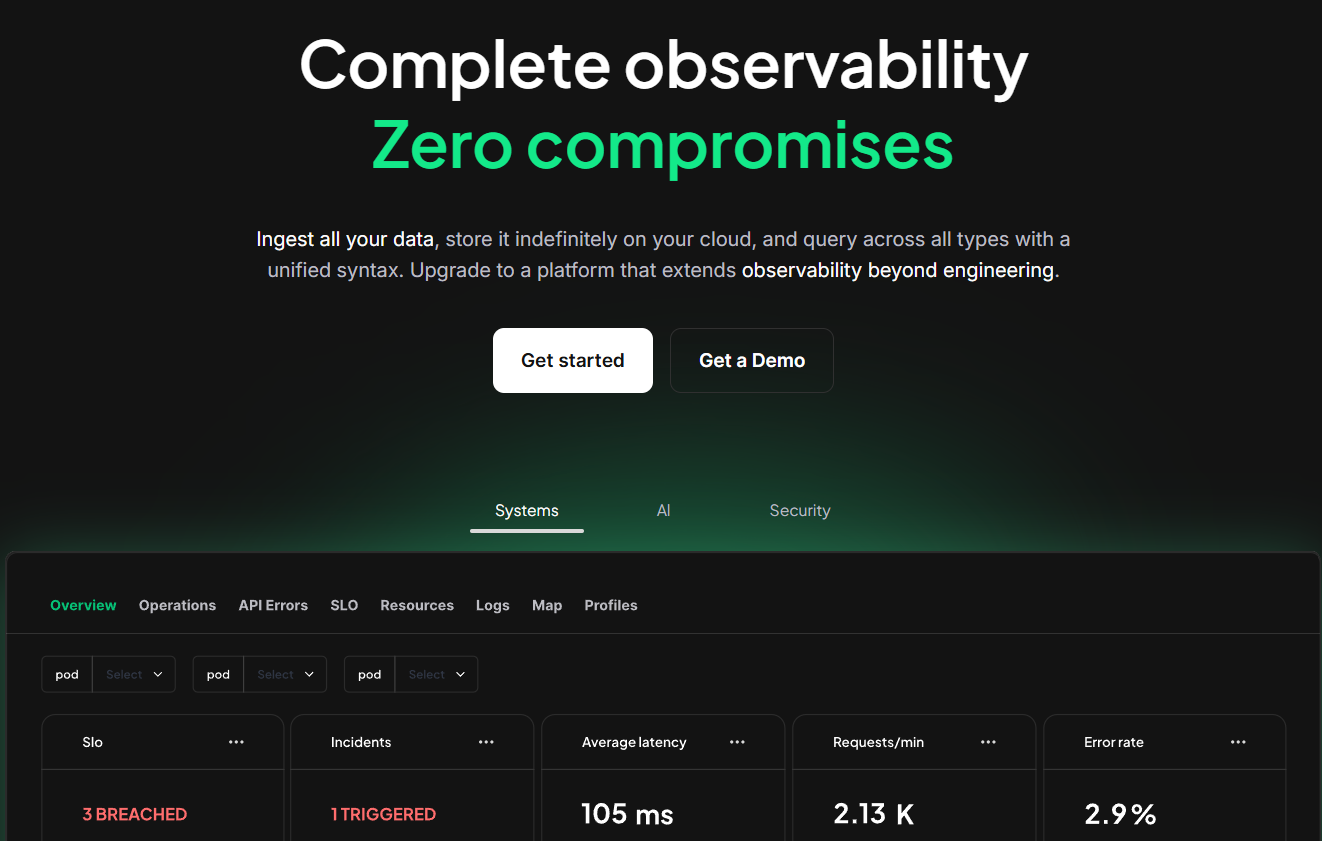
Known for:
Log-first observability with real-time stream processing and flexible data routing.
Coralogix is a modern observability platform that emphasizes log analytics and cost control. Its unique Streama™ architecture allows logs, metrics, and traces to be parsed and routed in real time — even before storage — making it popular for teams prioritizing ingestion control.
Key Features:
- Streama™ Architecture: Real-time processing pipeline lets users route telemetry before indexing to control costs.
- Log Management: Highly scalable log ingestion with customizable parsing, tagging, and pipelines.
- Metrics & Traces: Integrated support for metrics and distributed tracing via OpenTelemetry.
- Dynamic Data Routing: Archive, monitor, or drop data based on routing rules — before paying for storage.
- Built-in Dashboards & Alerting: Pre-built views for ELK, Kubernetes, and serverless environments.
- Compliance & Archival: Archived data stored in the customer’s own cloud account (e.g., S3, GCS).
Standout Features:
- Unique data routing logic helps optimize ingestion costs dramatically.
- Archived data stored in your own cloud, reducing long-term storage costs.
- Live tailing, full-text search, and correlation for fast log investigation.
- ISO, GDPR, SOC 2, and other compliance certifications in place.
Pros:
- Excellent for log-heavy environments (e.g., Kubernetes, CI/CD pipelines).
- Advanced log pipeline customization and filtering.
- Strong OpenTelemetry support for traces and metrics.
- Smart cost control via real-time filtering and dynamic routing.
Cons:
- Log-first tool — tracing and metrics are not as mature as dedicated APMs.
- No native RUM or synthetics, making it less effective for frontend observability.
- Archived telemetry is stored in the customer’s cloud, but still incurs egress charges from Coralogix before reaching archive — a potential data localization and cost concern.
- Pricing may appear lower, but ingestion + archive + routing costs add complexity.
Best for:
- Teams that ingest high volumes of logs and want granular control over what to store.
- Organizations focused on compliance and cost-optimized log retention.
Pricing & Customer Reviews:
- Pricing: Three-tier plans from ~$245.55/month, billed annually
- G2 Review Rating: 4.6/5
Customers appreciate Coralogix for its streaming-first architecture and cost flexibility, but warn of pricing complexity, log-only focus, and lack of end-to-end observability.
Coralogix vs Uptrace:
Coralogix is ideal for teams who want advanced log analytics and pipeline control, while Uptrace focuses on tracing and metrics. However, both lack full-stack coverage. For teams looking to unify logs, traces, infra, and synthetics — CubeAPM offers the best of both worlds, with transparent pricing and native OTEL compatibility.
8. Sumo Logic
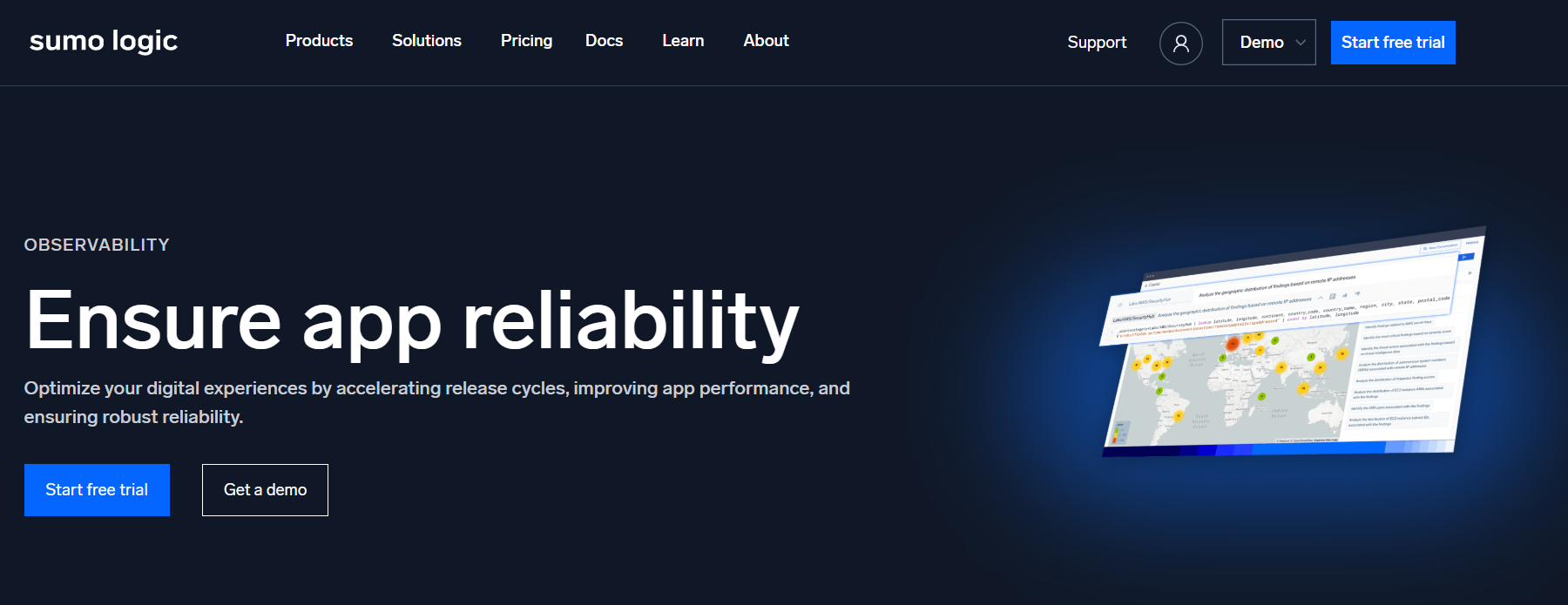
Known for:
Cloud-native log analytics with built-in security, metrics, and monitoring for enterprise DevSecOps.
Sumo Logic is a SaaS-based observability and SIEM platform offering unified visibility across logs, metrics, and security analytics. It’s widely used by enterprises seeking compliance-ready cloud observability with native integrations for AWS, GCP, and Azure.
Key Features:
- Log Management & Analytics: Powerful search and correlation engine for real-time log ingestion and visualization.
- Metrics Monitoring: Tracks system and app-level metrics with custom dashboards and alerts.
- Cloud-Native Integrations: Deep support for Kubernetes, AWS, Azure, GCP, and serverless environments.
- Security Analytics (SIEM): Includes threat detection, compliance audits, and incident response modules.
- Dashboards & Alerting: Built-in content packs, alerts, and customizable dashboards.
- Machine Learning Insights: Detects anomalies, outliers, and trends using predictive models.
Standout Features:
- All-in-one platform for observability + security — great for DevSecOps teams.
- SOC 2, GDPR, HIPAA compliance ready.
- Query-based log search + visualization similar to Splunk and ELK.
- Real-time correlation across telemetry and security events.
Pros:
- Strong log analysis and compliance tooling.
- Scalable architecture for large orgs with multi-cloud environments.
- Integrated security and observability workflows.
- Extensive prebuilt dashboards for common services.
Cons:
- Expensive and tiered pricing — especially for long-term retention and high ingestion.
- No native OpenTelemetry pipeline — limited OTEL flexibility compared to newer tools.
- Limited tracing support — requires significant setup for full APM capabilities.
- No self-hosting option — SaaS-only, which raises data residency concerns.
Best for:
- Enterprises with strong security + compliance requirements.
- Teams already committed to SaaS infrastructure and log-first workflows.
Pricing & Customer Reviews:
- Pricing: Starts around $3.30–$4.50 per TB scanned
- G2 Review Rating: 4.2/5
Customers value Sumo Logic for its security integrations and scalable log management, but commonly cite cost, rigid plans, and limited tracing as reasons to explore other APM options.
Sumo Logic vs Uptrace:
Sumo Logic provides stronger security analytics and log compliance, while Uptrace focuses on traces and OTEL-based debugging. However, neither delivers unified MELT observability. CubeAPM combines both capabilities — logs, traces, RUM, and synthetics — under one roof with predictable pricing and OpenTelemetry-native ingest.
Conclusion: Choosing the Right Uptrace Alternative
As observability needs mature, many teams are moving beyond lightweight tracing tools like Uptrace in search of platforms that offer full MELT visibility, cost control, and enterprise-grade reliability. Whether it’s the need for real user monitoring, smarter sampling, or self-hosted compliance — the market now offers modern, OpenTelemetry-friendly alternatives that go far beyond what Uptrace was built to do.
Why CubeAPM Leads the Pack
Among all Uptrace alternatives, CubeAPM stands out for its OpenTelemetry-first design, smart sampling, full-stack observability, and blazing-fast, compliance-ready hosting options. With 60–80% cost savings, no per-user fees, and support for logs, infra, synthetics, RUM, and traces — CubeAPM delivers everything modern engineering teams need, without the operational drag or pricing surprises.
Whether you’re scaling past Uptrace’s limitations or seeking deeper visibility without vendor lock-in, CubeAPM offers a frictionless, developer-friendly, and future-ready upgrade — built for the next generation of observability.

